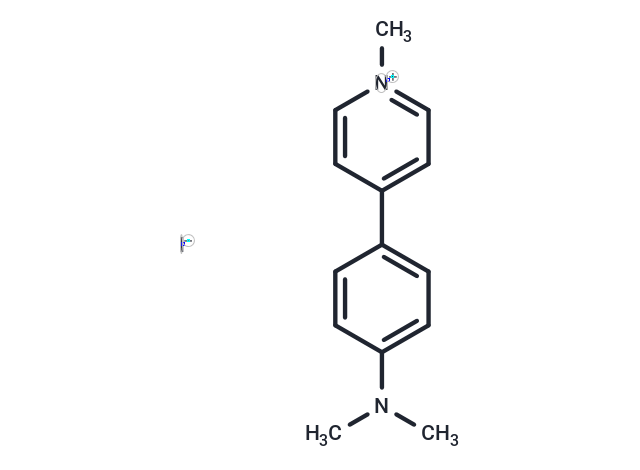Shopping Cart
Remove All Your shopping cart is currently empty
Your shopping cart is currently empty
IDT307 is a fluorescent analog of MPP+, a fluorescent substrate for DAT (fluorescent substrate APP+), and can be used for rapid identification and characterization of PMAT inhibitors.

| Pack Size | Price | USA Warehouse | Global Warehouse | Quantity |
|---|---|---|---|---|
| 2 mg | $29 | - | In Stock |
| Description | IDT307 is a fluorescent analog of MPP+, a fluorescent substrate for DAT (fluorescent substrate APP+), and can be used for rapid identification and characterization of PMAT inhibitors. |
| In vitro | IDT307 is an analog of the organic cation MPP+, which is transported to the parietal membrane (cerebrospinal fluid-facing side) of choroid plexus (CP) epithelial cells. Its transport process is highly sensitive to the PMAT inhibitor quinine. In Pmat knockout mice, uptake of IDT307 by choroid plexus tissue and its intracellular accumulation are significantly reduced by approximately 70%. [1] |
| Cell Research | 1. For PMAT inhibitor screening 1. Cell preparation: In cell culture, select a cell line suitable for the study, such as cells expressing PMAT. 2. Add IDT307: Add IDT307 to the cell culture medium, usually at a concentration of 1-50 μM. 3. Inhibitor treatment: Add a known PMAT inhibitor or potential inhibitor to the experiment, and detect fluorescence changes after a certain period of culture. 4. Fluorescence detection: Detect the fluorescence changes of IDT307 by fluorescence microscopy or fluorescence microplate reader (usually using Ex: 485 nm, Em: 535 nm wavelength). A decrease in fluorescence intensity usually means the inhibitory effect of PMAT. 2. For DAT substrate characterization 1. Cell preparation: Perform experiments in neuronal cell lines with DAT expression. 2. Add IDT307: Dissolve IDT307 in an appropriate buffer and add it to the cell culture medium. 3. Fluorescence detection: At appropriate time points, measure the fluorescence signal by fluorescence microscopy or spectrophotometer to observe DAT-mediated IDT307 transport. III. Evaluation of dopamine transporter function 1. Cell preparation: Use cell lines with DAT expression, or extract neurons from mouse brain tissue for experiments. 2. Add IDT307: Add IDT307 to the culture medium and incubate the cells for a certain period of time. 3. Fluorescence detection: Use appropriate fluorescence detection equipment to monitor the changes in the fluorescence intensity of IDT307 and then evaluate the DAT function. |
| Synonyms | IDT 307 |
| Molecular Weight | 340.2 |
| Formula | C14H17IN2 |
| Cas No. | 1141-41-9 |
| Smiles | [I-].C=1C=C(C=CC1C=2C=C[N+](=CC2)C)N(C)C |
| Relative Density. | no data available |
| Storage | keep away from direct sunlight | Powder: -20°C for 3 years | In solvent: -80°C for 1 year | Shipping with blue ice/Shipping at ambient temperature. | |||||||||||||||||||||||||||||||||||
| Solubility Information | DMSO: 50 mg/mL (146.97 mM), Sonication is recommended. | |||||||||||||||||||||||||||||||||||
| In Vivo Formulation | 10% DMSO+40% PEG300+5% Tween-80+45% Saline: 2.5 mg/mL (7.35 mM), Sonication is recommeded. Please add the solvents sequentially, clarifying the solution as much as possible before adding the next one. Dissolve by heating and/or sonication if necessary. Working solution is recommended to be prepared and used immediately. The formulation provided above is for reference purposes only. In vivo formulations may vary and should be modified based on specific experimental conditions. | |||||||||||||||||||||||||||||||||||
Solution Preparation Table | ||||||||||||||||||||||||||||||||||||
DMSO
| ||||||||||||||||||||||||||||||||||||
| Size | Quantity | Unit Price | Amount | Operation |
|---|

Copyright © 2015-2025 TargetMol Chemicals Inc. All Rights Reserved.